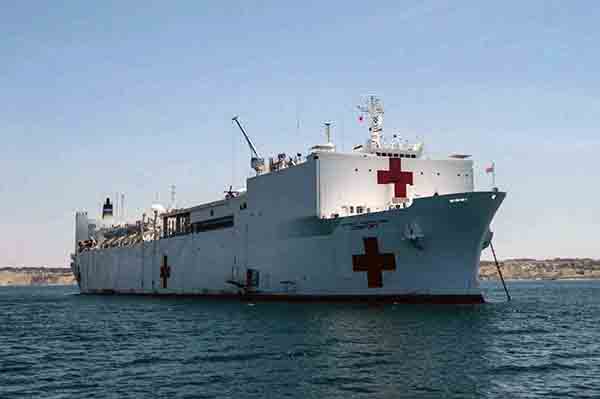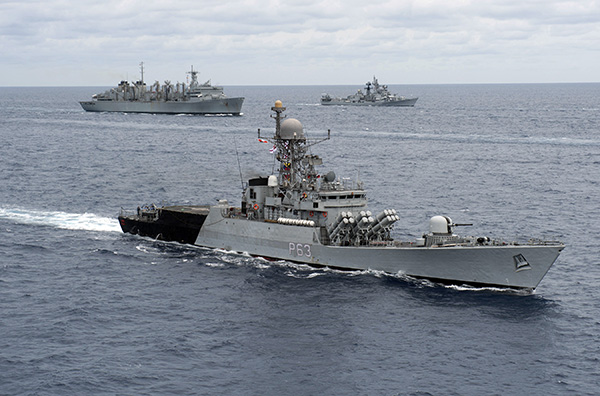Old Combatants Decommissioned
The Defence Acquisition Council (DAC), on 6 June, accorded acceptance of necessity (AoN) for the procurement of eight next generation corvettes (NGC) at an estimated cost of Rs 36,000 crore. The AoN is the first step for the procurement procedure.
These next generation corvettes are part of the Indian Navy’s ongoing plan to have a 175-ship Navy. The warships, the NGC, will be versatile platforms for variety of roles like surveillance missions, escort operations, deterrence, surface action group (SAG) operations, search and attack and coastal defence. These NGCs would be constructed based on new in-house design of Indian Navy using latest technology of ship-building.
Survey Vessel Launched
Nirdeshak, the second of the four Survey Vessels (Large) (SVL) projects being built by Garden Reach Shipbuilders and Engineers (GRSE) in collaboration with L&T shipbuilding for the Indian Navy was launched on 26 May at Kattupalli, Chennai.
The vessel has taken its name from erstwhile Nirdeshak which was also an Indian Naval Survey ship and was decommissioned after 32 years of glorious service in December 2014.
Part construction of three out of four ships of SVL is being undertaken at L&T, Kattupalli as part of a collaborative approach between GRSE and L&T shipbuilding. This model of Public-Private Partnership shall be a harbinger of future successful collaboration for Warship construction in India.
The contract for building four SVL ships was signed between MoD and GRSE, Kolkata on October 30, 2018. The first of class ship ‘Sandhayak’ was launched in December 2021 at GRSE, Kolkata.
The SVL ships will replace the existing Sandhayak Class survey ships with new generation hydrographic equipment to collect oceanographic data. The Survey Vessel (Large) ships have a deep displacement of about 3400 tons and a complement of 235 personnel.
The ship is designed to operate at a cruise speed of 14 knots and a maximum speed of 18 knots. Bow and Stern Thrusters have been catered for better manoeuvring at low speeds required during shallow water survey operations. The hull of these ships is made from indigenously developed DMR 249-A steel manufactured by Steel Authority of India Limited.
With the capability to carry four Survey Motor Boats and an integral helicopter, the primary role of the ships would be to undertake full scale coastal and deep-water hydrographic surveys of Ports and navigational channels. The ships would also be deployed for collecting oceanographic and geophysical data for defence as well as civil applications. In their secondary role, the ships are capable of providing limited defence, besides serving as Hospital ships during emergencies.
National Hospital Ship
The Ministry of Defence issued a Request for Information to buy one National Hospital Ship for the Indian Navy from registered Indian Shipyards, on 18 May. The National Hospital Ship would be able to provide Primary and Secondary Care to the patients on board, and the first vessel would be delivered within 48 months of the contract’s signing.


The National Hospital Ship will be painted white in accordance with the Geneva Convention, with the Red Cross prominently visible on the ship’s side and top. The National Medical Ship will be required to carry a maximum of 600 people onboard, including 250 patients and 117 hospital personnel.
It will feature a crew of 15 officers and 120 sailors, as well as a medical crew of 22 officers, 14 Military Nursing Service Staffs, and 81 sailors. The National Hospital Ship will be under 15000 tons in displacement and have a minimum service life of 20 years.
Ships Decommissioned
Two naval warships, INS Nishank and INS Akshay, were decommissioned on 3 June after 32 years of being at the forefront of safeguarding the maritime interests of the nation.
INS Nishank, the fourth of the Veer Class Missile Corvette, was an integral part of the Killer Squadron, renowned for its heroics in the 1971 India-Pakistan War.
It held the distinction of having operated on both the eastern as well as western seaboards. The ship was armed with surface-to-surface missile. It has been earmarked to be displayed as a war relic at a suitable historic location.
INS Akshay was part of the 23rd Patrol Vessel Squadron, whose primary role is anti-submarine warfare and coastal patrol. With a formidable armament of long-range torpedoes and anti-submarine rockets, the ‘submarine hunter’ was perennially on petrol, keeping enemy submarines at bay.
INS Gomati, a Godavari class guided-missile frigate, was decommissioned, on 28 May, after 34 years of service. It was commissioned on April 16, 1988.
The ship had been deployed in Operations Cactus, Parakram and Rainbow.
Gomati was designed by the Indian Navy and built in an Indian shipyard, and these were initial steps towards an Atmanirbhar Bharat (self-reliant India).
Gomati’s legacy will be kept alive in an open air museum being set up on the banks of the Gomti river (from which the frigate derives her name) in Lucknow where several of her combat systems will be displayed as military and war relics.
The Uttar Pradesh government and Indian Navy have signed a Memorandum of Understanding for this purpose.
Digital Coast Guard Project
The DAC also gave apporval for the “Digital Coast Guard” Project under the ‘Buy (Indian) Category’ has been approved by the DAC. Under this project, a pan India secure network for digitising various surface and aviation operations, logistics, finance and HR processes in the Indian Coast Guard will be established.













